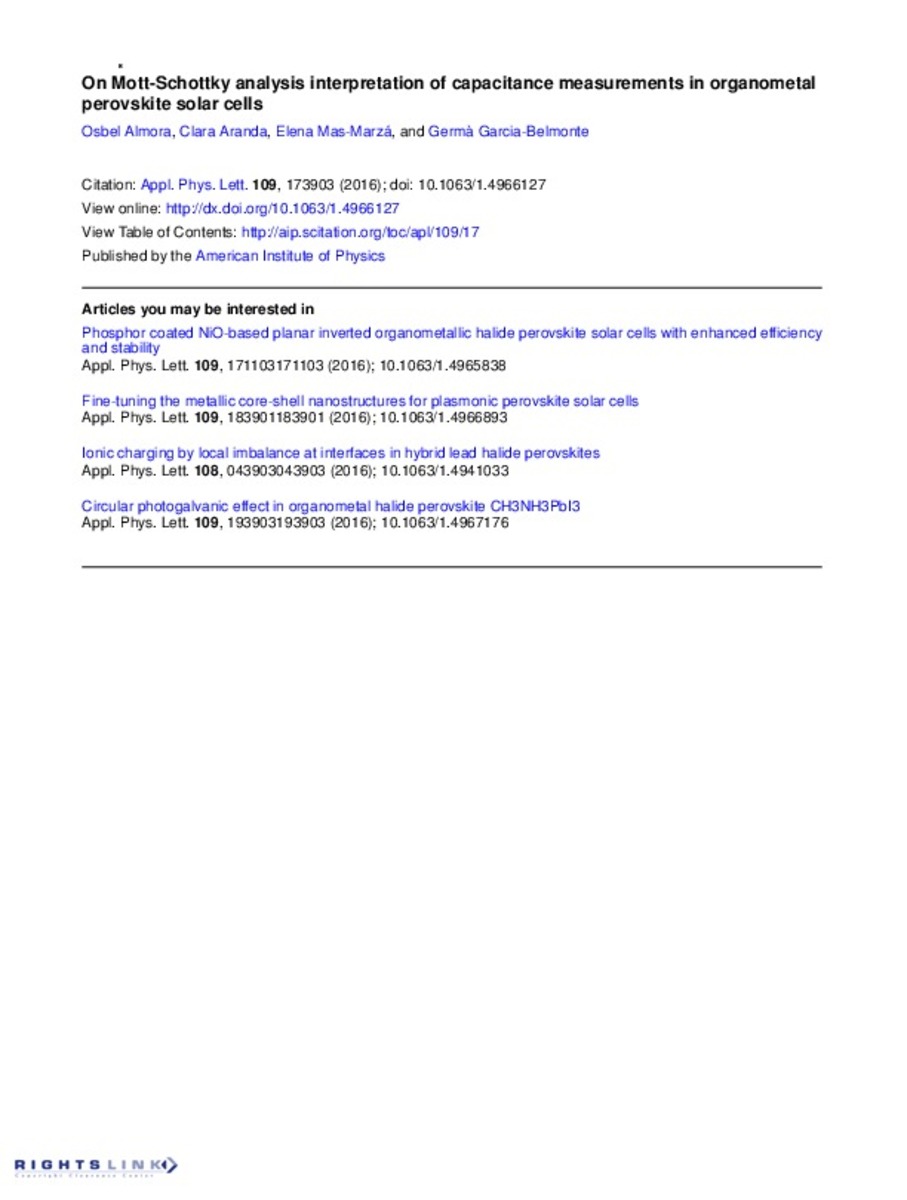Mostrar el registro sencillo del ítem
On Mott-Schottky analysis interpretation of capacitance measurements in organometal perovskite solar cells
| dc.contributor.author | Almora Rodríguez, Osbel | |
| dc.contributor.author | Aranda Alonso, Clara | |
| dc.contributor.author | Mas, Elena | |
| dc.contributor.author | Garcia-Belmonte, Germà | |
| dc.date.accessioned | 2017-01-19T11:21:50Z | |
| dc.date.available | 2017-01-19T11:21:50Z | |
| dc.date.issued | 2016 | |
| dc.identifier.citation | ALMORA, Osbel, et al. On Mott-Schottky analysis interpretation of capacitance measurements in organometal perovskite solar cells. Applied Physics Letters, 2016, vol. 109, no 17, p. 173903 | ca_CA |
| dc.identifier.issn | 0003-6951 | |
| dc.identifier.issn | 1077-3118 | |
| dc.identifier.uri | http://hdl.handle.net/10234/165411 | |
| dc.description.abstract | Capacitance response of perovskite-based solar cells (PSCs) can be exploited to infer underlying physical mechanisms, both in the materials bulk and at outer interfaces. Particularly interesting is applying the depletion layer capacitance theory to PSCs, following common procedures used with inorganic and organic photovoltaic devices. Voltage-modulation of the depletion layer width allows extracting relevant parameters as the absorber defect density and built-in potential by means of the Mott-Schottky (MS) analysis. However, the uncritical use of the MS technique may be misleading and yields incorrect outcomes as a consequence of masking effects that accumulation capacitances, commonly observed in PSCs, produce on the measured capacitance value. Rules are provided here to select the measuring frequency that allows extracting depletion layer capacitance, and the voltage range in which it dominates, avoiding accumulation capacitive parasitic contributions. It is noted that the distinction of the depletion capacitance from the accumulation capacitance is only feasible in the case of perovskite layers containing significant defect density (∼1017 cm−3). It is confirmed that MS reproducibility is assured by hysteresis reduction at slow scan rates, and positive bias starting polarization. A complete procedure with specific checking points is provided here for consistent MS measurement and interpretation. | ca_CA |
| dc.description.sponsorShip | We thank the Ministerio de Economía y Competitividad (MINECO) of Spain for financial support under Projects (MAT2013-47192-C3-1-R and MAT2016-76892-C3-1-R), and Generalitat Valenciana (Prometeo/2014/020). O.A. acknowledges Generalitat Valenciana for a Grant (GRISOLIAP2014/035). E.M.-M. thanks the Ramón y Cajal program from MINECO of Spain. SCIC at UJI are also acknowledged. | ca_CA |
| dc.format.extent | 6 p. | ca_CA |
| dc.format.mimetype | application/pdf | ca_CA |
| dc.language.iso | eng | ca_CA |
| dc.publisher | AIP Publishing | ca_CA |
| dc.relation.isPartOf | Applied Physics Letters, 2016, vol. 109, no 17 | ca_CA |
| dc.rights | © AIP Publishing | ca_CA |
| dc.rights.uri | http://rightsstatements.org/vocab/InC/1.0/ | * |
| dc.subject | capacitance | ca_CA |
| dc.subject | solar cells | ca_CA |
| dc.subject | dielectric oxides | ca_CA |
| dc.subject | materials analysis | ca_CA |
| dc.subject | frequency analyzers | ca_CA |
| dc.title | On Mott-Schottky analysis interpretation of capacitance measurements in organometal perovskite solar cells | ca_CA |
| dc.type | info:eu-repo/semantics/article | ca_CA |
| dc.identifier.doi | http://dx.doi.org/10.1063/1.4966127 | |
| dc.rights.accessRights | info:eu-repo/semantics/openAccess | ca_CA |
| dc.relation.publisherVersion | http://aip.scitation.org/doi/full/10.1063/1.4966127 | ca_CA |
| dc.type.version | info:eu-repo/semantics/publishedVersion |
Ficheros en el ítem
Este ítem aparece en la(s) siguiente(s) colección(ones)
-
FCA_Articles [501]
Articles de publicacions periódiques







